Spun polyester fabric is a dynamic textile material renowned for its durability, versatility, and cost-effectiveness.
Crafted from synthetic polyester fibers, this fabric undergoes a meticulous spinning process, resulting in threads that are subsequently woven or knitted to create an array of fabrics.
Its robust nature makes it an ideal choice for a spectrum of applications, from workwear to outdoor furnishings. Spun polyester’s resistance to wrinkles, quick-drying properties, and vibrant color retention set it apart in the textile world.
Moreover, its affordability and easy maintenance further solidify its status as a practical and widely utilized material. Understanding its properties and applications underscores its importance in various industries.
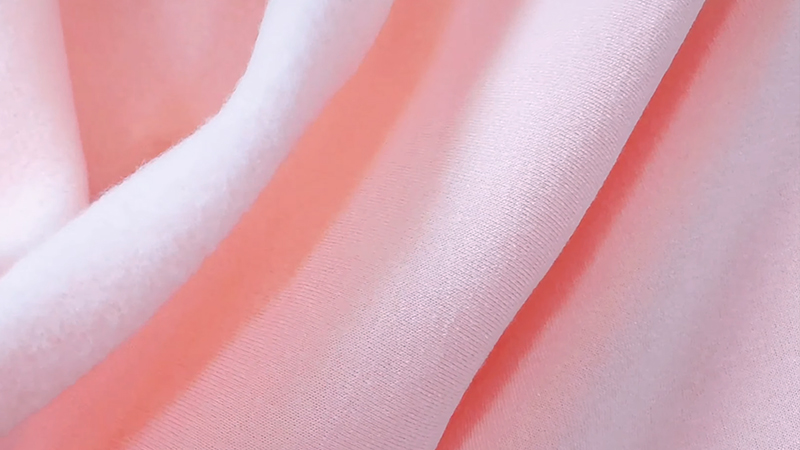
What Is Spun Polyester Fabric?
Spun polyester fabric is a type of textile material that is made from polyester fibers. It is created through a process called spinning, in which the polyester fibers are extruded and twisted together to form threads.
These threads are then woven or knitted together to produce a wide range of fabrics with various textures, patterns, and weights.
Here are some key characteristics and features of spun polyester fabric:
Durability
Spun polyester fabric is engineered to withstand the rigors of daily use. Its high tensile strength and resistance to abrasion make it ideal for items that are subject to frequent wear, such as work uniforms, outdoor gear, and upholstery in high-traffic areas.
Resistant to Wrinkling
The inherent resilience of polyester fibers means that fabrics made from them are less prone to creasing.
This characteristic makes spun polyester an excellent choice for travel clothing, bedding, and drapery, as it retains its smooth appearance even after extended periods of use.
Quick Drying
Polyester’s ability to efficiently wick away moisture from the skin, combined with its rapid drying properties, is invaluable for activewear and sportswear.
This quality helps keep the wearer comfortable during physical activities and reduces the risk of discomfort due to perspiration.
Stain Resistance
Spun polyester fabric is naturally less susceptible to staining compared to natural fibers. It repels liquids more effectively, making it suitable for items like tablecloths, restaurant uniforms, and linens in homes with children or pets.
Color Fastness
The vibrant colors of spun polyester fabric tend to endure over time, even with repeated washing.
This resilience to fading or dulling ensures that items like outdoor cushions, curtains, and flags maintain their visual appeal, even in the face of prolonged exposure to the elements.
Versatility
Spun polyester fabric comes in an array of weights, weaves, and finishes, allowing it to adapt to a wide range of applications.
Lighter weights may be used for delicate apparel, while heavier options are well-suited for upholstery, backpacks, and industrial filters.
Affordability
Polyester is generally more cost-effective to produce than natural fibers like silk or wool. This makes spun polyester fabric a practical choice for bulk orders and industries where budget constraints are a consideration.
Easy Care
Products made from spun polyester are known for their low-maintenance requirements.
They can usually be machine-washed and dried at lower temperatures, making them convenient choices for busy households, hospitality establishments, and healthcare facilities.
Hypoallergenic
For individuals with sensitive skin or allergies, spun polyester fabric can be a preferable choice. It is less likely to cause skin irritations compared to fabrics made from certain natural fibers.
Environmental Considerations
While polyester is derived from petrochemicals, efforts have been made to produce it in more sustainable ways.
Recycled polyester fibers, made from reclaimed plastic bottles or other sources, represent a positive step towards reducing the environmental impact associated with the production of virgin polyester.
Composition of Spun Polyester Fabric
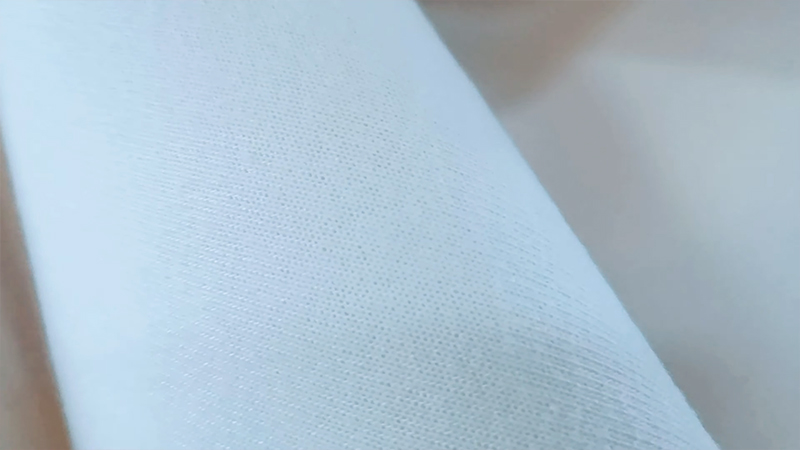
Spun polyester fabric is made from synthetic polyester fibers. These fibers are produced through a chemical process that starts with the polymerization of a raw material called ethylene glycol and terephthalic acid.
The resulting polymer is then extruded and spun into fine filaments, which are later processed into fibers for weaving or knitting into fabric.
The composition of spun polyester fabric typically consists of the following elements:
Polyester Fibers
The primary component of spun polyester fabric is polyester fibers. These fibers are long chains of repeating units, with the chemical formula (C10H8O4)n, where “n” represents the number of repeating units.
The most commonly used type of polyester for textile production is polyethylene terephthalate (PET).
Dye
Spun polyester fabric can be dyed in various colors to achieve the desired appearance.
Dye molecules adhere to the polyester fibers during the dyeing process, imparting color to the fabric. The dye used can be either water-based or dispersed dyes, depending on the specific application and colorfastness requirements.
Finishes and Treatments
Depending on the intended use of the fabric, spun polyester may undergo various finishing treatments.
These treatments can include anti-static finishes, wrinkle-resistant finishes, flame-retardant treatments, and more. These additional elements may be applied to enhance specific properties of the fabric.
Antimicrobial Agents
In some cases, spun polyester fabric may be treated with antimicrobial agents to inhibit the growth of bacteria and microbes. This is often seen in healthcare textiles or environments where hygiene is critical.
UV Stabilizers
For outdoor applications or fabrics exposed to sunlight, UV stabilizers may be added to the polyester to protect against degradation and color fading caused by UV radiation.
Recycled Content
Some spun polyester fabrics may include recycled polyester fibers obtained from post-consumer plastic bottles or other sources.
This incorporation of recycled content aligns with sustainability efforts and reduces the demand for virgin polyester production.
Difference Among Spun Polyester Fabric and Other Fabrics
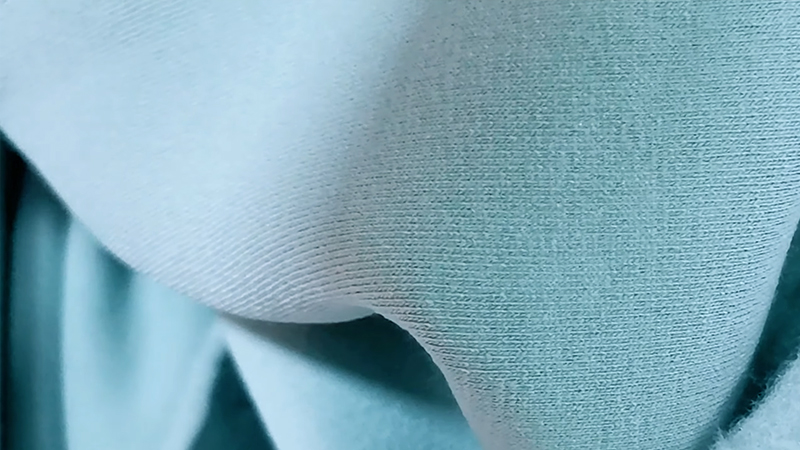
Spun polyester fabric, like any textile material, has distinct differences when compared to various other fabrics. These disparities stem from variations in composition, properties, and intended applications.
Let’s explore the notable differences between spun polyester fabric and several other commonly used fabrics:
Cotton vs. Spun Polyester Fabric
- Composition: Cotton is a natural fiber, while spun polyester is synthetic.
- Characteristics:
- Cotton is breathable, soft, and comfortable, ideal for warm weather.
- Spun polyester is durable, wrinkle-resistant, and often used for workwear and table linens.
- Care: Cotton may shrink and require ironing, whereas spun polyester is low-maintenance and holds its shape.
Wool vs. Spun Polyester Fabric
- Composition: Wool is a natural protein fiber, and spun polyester is synthetic.
- Characteristics:
- Wool is warm, moisture-wicking, and luxurious but can be itchy.
- Spun polyester is durable, quick-drying, and lacks the natural warmth of wool.
- Care: Wool requires special care, while spun polyester is easy to clean.
Nylon vs. Spun Polyester Fabric
- Composition: Both are synthetic fibers made from petrochemicals.
- Characteristics:
- Nylon is strong, quick-drying, and often used in sportswear.
- Spun polyester is durable, wrinkle-resistant, and versatile for various applications.
- Breathability: Spun polyester is generally more breathable than nylon.
Silk vs. Spun Polyester Fabric
- Composition: Silk is a natural protein fiber, and spun polyester is synthetic.
- Characteristics:
- Silk is luxurious, soft, and breathable with a natural shine.
- Spun polyester is durable, affordable, and less prone to damage.
- Care: Silk requires delicate handling and is more expensive than spun polyester.
Rayon vs. Spun Polyester Fabric
- Composition: Rayon is semi-synthetic, while spun polyester is fully synthetic.
- Characteristics:
- Rayon can mimic natural fibers but is less durable.
- Spun polyester is strong, resistant to wrinkles, and cost-effective.
- Wrinkle-Resistance: Spun polyester outperforms rayon in wrinkle resistance.
Linen vs. Spun Polyester Fabric
- Composition: Linen is a natural fiber from the flax plant.
- Characteristics:
- Linen is breathable, textured, and has a casual appearance.
- Spun polyester is more durable, wrinkle-resistant, and budget-friendly.
- Wrinkle: Linen tends to wrinkle easily, while spun polyester maintains a neater appearance.
Popular Applications Of Spun Polyester Fabric
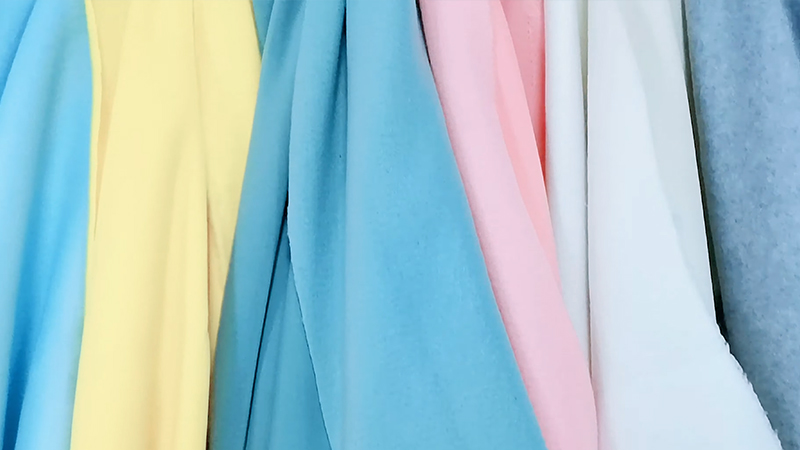
Spun polyester fabric finds a wide range of applications across various industries due to its versatile and durable nature.
Here are some of the popular applications of spun polyester fabric:
Apparel
- Workwear: Spun polyester’s durability makes it a preferred choice for work uniforms in industries like construction, manufacturing, and transportation.
- Sportswear: Its quick-drying and moisture-wicking properties make it ideal for activewear, including jerseys, shorts, and athletic pants.
- Outdoor Clothing: Spun polyester’s resistance to water and UV radiation makes it suitable for outdoor clothing like jackets, raincoats, and hiking gear.
Home Textiles
- Bedding and Linens: Spun polyester is used for bed sheets, pillowcases, and duvet covers due to its wrinkle-resistance and easy-care nature.
- Table Linens: Its stain resistance makes it a popular choice for tablecloths, napkins, and placemats in restaurants and households.
- Curtains and Drapes: Spun polyester’s colorfastness and durability are advantageous for window treatments.
Upholstery
- Furniture: Spun polyester fabric is often used for upholstery on sofas, chairs, and other furniture pieces, especially in high-traffic areas.
- Outdoor Furniture: Its resistance to moisture and UV rays makes it a suitable choice for outdoor cushions and covers.
Bags and Accessories
- Backpacks and Bags: Spun polyester’s strength and durability make it a popular material for backpacks, tote bags, and luggage.
- Accessories: It is used for items like wallets, belts, and hats due to its wear resistance and color options.
Medical and Healthcare
- Scrubs and Lab Coats: Spun polyester’s easy-care and stain-resistant properties are valuable in medical attire.
- Bedding in Healthcare Settings: Its durability and ease of cleaning make it suitable for healthcare facility linens.
Flags and Banners
- Outdoor Flags: Spun polyester’s resistance to weather conditions and UV radiation makes it an excellent choice for flags flown outdoors.
- Indoor Banners: Its vibrant color options and wrinkle resistance make it suitable for indoor banners and displays.
Industrial and Automotive
- Safety Apparel: Spun polyester fabric is used for high-visibility safety vests and jackets due to its durability and visibility-enhancing properties.
- Automotive Interiors: Its resistance to wear and tear makes it suitable for car seat covers, headliners, and interior panels.
Care and Maintenance of Spun Polyester Fabric
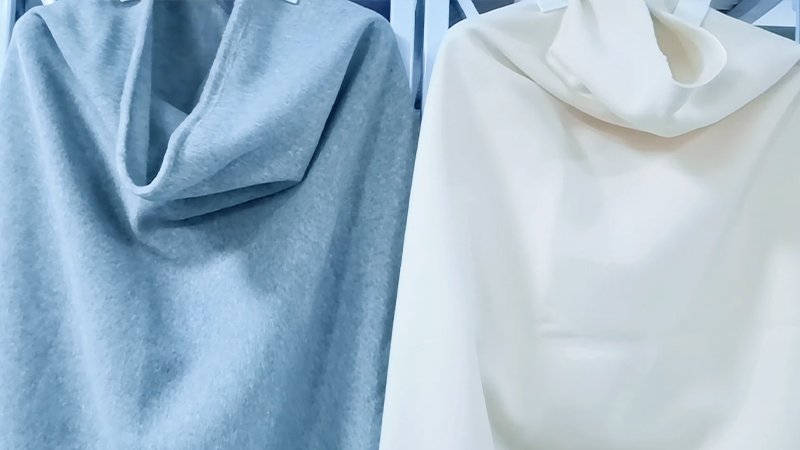
Taking proper care of spun polyester fabric can help prolong its lifespan and maintain its appearance.
Here are some guidelines for the care and maintenance of spun polyester fabric:
Machine Washing
When machine washing spun polyester fabric, it’s important to select a gentle cycle with cold or lukewarm water. This helps prevent excessive agitation, which can lead to wear and tear over time.
Additionally, using a mild detergent is recommended to effectively clean the fabric without causing any damage. Avoid using bleach or fabric softeners, as they can weaken the fabric’s fibers and diminish its longevity.
Drying
Spun polyester fabric is known for its quick-drying properties. When using a dryer, opt for a low-heat setting to avoid subjecting the fabric to high temperatures.
This precaution helps prevent potential shrinkage or damage. If possible, consider air drying the fabric, especially for items with specific shapes or delicate finishes. This method ensures a gentler drying process.
Ironing
Should ironing be necessary, it’s advisable to use a low-heat setting. This precautionary measure helps prevent the fabric from becoming overheated, which could lead to distortion or damage.
Placing a cloth or a pressing cloth between the iron and the fabric is a smart practice.
This additional layer provides an extra buffer and minimizes direct contact with the heated surface.
Stain Removal
Promptly addressing stains on spun polyester fabric is crucial to prevent them from setting in. Begin by using a mild detergent or a specialized stain remover.
However, it’s wise to conduct a spot test on an inconspicuous area first to ensure the treatment doesn’t affect the fabric’s color or integrity. Gently blot or dab the stain, rather than vigorously rubbing, which can exacerbate the issue.
Avoiding Abrasion
To maintain the integrity of spun polyester fabric, be cautious around abrasive surfaces or sharp objects that could potentially snag or cause friction.
This is particularly important for items used in high-traffic areas or outdoor settings where they may come into contact with rough surfaces.
Storage
Proper storage of spun polyester fabric helps preserve its quality. Opt for a cool, dry location away from direct sunlight.
Prolonged exposure to sunlight can lead to fading or discoloration over time. If possible, store the fabric in a breathable fabric bag or container to protect it from dust and moisture.
Avoiding Harsh Chemicals
Spun polyester fabric should be kept away from harsh chemicals, such as bleach, solvents, or strong acids.
These substances can weaken the fabric’s fibers and potentially cause irreversible damage. When cleaning or treating stains, opt for mild and fabric-friendly solutions.
Professional Cleaning
For heavily soiled items or those with special finishes, professional cleaning services may be the best option.
Experienced cleaners are equipped with the knowledge and tools to effectively clean and maintain spun polyester fabric items.
Special Treatments
When the fabric has undergone special treatments, such as water repellency or flame retardance, it’s important to follow any care instructions provided by the manufacturer. These treatments may require specific care to ensure their continued effectiveness.
Avoiding Overloading
When machine washing spun polyester fabric, refrain from overloading the machine.
This ensures that the fabric has enough space to move freely, facilitating a thorough cleaning process without excessive friction or stress on the fibers.
Checking Label Instructions
Always refer to the care label attached to the fabric or garment for specific care instructions recommended by the manufacturer.
These instructions are tailored to the specific type and blend of fabric used, providing the most accurate guidance for proper care.
FAQs
What is Spun Polyester Fabric?
Spun polyester fabric is a type of textile material made from synthetic polyester fibers. It is created through a process of spinning these fibers into threads.
Can Spun Polyester Fabric be Used for Outdoor Furniture?
Yes, spun polyester fabric is a popular choice for outdoor furniture upholstery.
Is Spun Polyester Fabric Suitable for Athletic Apparel?
Yes, spun polyester fabric is commonly used in athletic apparel. Its quick drying and moisture-wicking properties make it an excellent choice for sportswear.
What are the Benefits of Using Spun Polyester Fabric in Workwear?
Spun polyester fabric is durable, resistant to wrinkles, and easy to maintain. These qualities make it an ideal material for work uniforms in industries where durability and a neat appearance are crucial.
Can Spun Polyester Fabric Be Dyed in Various Colors?
Yes, spun polyester fabric can be dyed in a wide range of colors.
To Recap
Spun polyester fabric stands as a versatile and durable textile, crafted from synthetic polyester fibers through a spinning process.
Its remarkable qualities, including high durability, resistance to wrinkles, and quick-drying properties, render it invaluable across numerous industries.
From sportswear to outdoor furniture upholstery, spun polyester’s adaptability shines. Moreover, its affordability and low-maintenance nature make it a pragmatic choice for various applications.
While derived from petrochemicals, efforts to incorporate recycled materials and employ sustainable production methods are steps toward mitigating environmental impact.
Overall, spun polyester fabric’s wide-ranging applications and enduring attributes position it as a cornerstone material in modern textile industries.
Leave a Reply